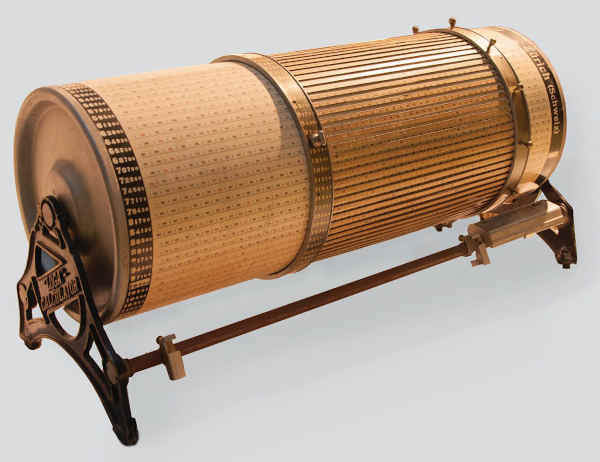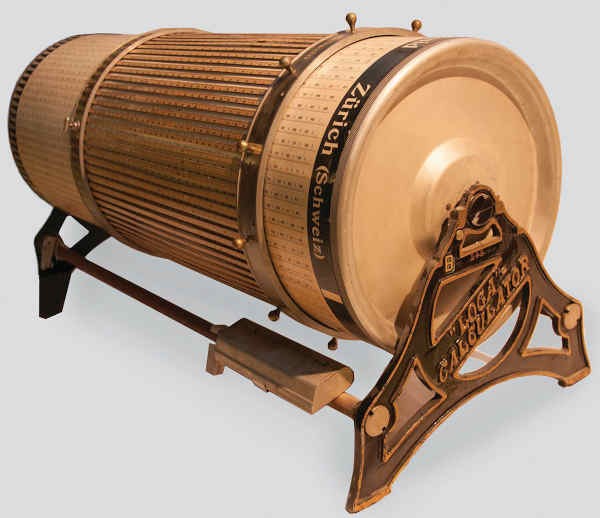
The world’s largest mass-produced cylindrical slide rules come from the Loga-Calculator AG in Zurich/Uster, Switzerland. They have a scale length of 24 m. Only a few copies have survived, almost all of them are located in Switzerland.
Different designs
There are several types of slide rules, including linear slide rules, circular slide rules, cylindrical slide rules, and pocket watch slide rules. Linear (straight) slide rules were widely used worldwide until the 1970s. Circular slide rules were also very popular. Pocket watch slide rules were less common. Cylindrical slide rules were produced in large quantities. However, 24-meter drums are very rare. The slide rule was invented in the 17th century by William Oughtred in the U.K.
Nine surviving specimens
When I began my research into the history of technology more than 10 years ago, only three surviving specimens of 24m cylindrical slide rules were known (see Figs. 1 and 2). Today we know 9 copies; almost all of them are in Switzerland. They are in public institutions such as the Historical Museum and Archive of the UBS (Basel), Museum of Communication (Bern), ETH Zurich (Department of Computer Science), University of Greifswald (Germany), and in private collections.
Fig. 1. Loga cylindrical slide rule with a scale length of 24 m (A). Credit: UBS
Loga Calculator AG, Zurich/Uster
The Loga Calculator AG was founded in 1900 by Heinrich Daemen Schmid and existed according to the Swiss commercial register until 2018, but stopped manufacturing analog mathematical instruments as early as 1978. The company was initially based in Zurich, and from 1911 in Uster near Zurich. Loga Calculator was probably the world’s leading manufacturer of cylindrical slide rules. The company offered cylindrical slide rules with scale lengths of 1.2 m; 2.4 m; 7.5 m; 10 m; 15 m and 24 m. How many cylindrical slide rules were manufactured is unknown. In addition to cylindrical slide rules Loga Calculator has also produced circular slide rules (see Fig. 3). The dating of slide rules is generally difficult. The company’s estate in the Swiss Economic Archives of the University of Basel does not contain any further details.
Further manufacturers
There were other cylindrical slide rule manufacturers in Switzerland such as Julius and Ernst Billeter (Zurich) and National Rechenwalzen AG (Zurich/Küsnacht). Important German manufacturers of slide rules were Dennert & Pape, Hamburg-Altona (Aristo), Faber-Castell, Stein near Nuremberg and Albert Nestler, Lahr, Baden/Black Forest. The best known American supplier was Keuffel & Esser Co., New York.
Fig. 2. Loga cylindrical slide rule with a scale length of 24 m (B). Credit: UBS
Scale length of 24 m
The drums of the 24 m analog calculators are of course not 24 m long. On the cylinder there are 80 scale sections of 60 cm, which results in a scale length of 48 m. For technical reasons (handling of the sleeve) the scale sections must overlap. They are applied twice. Therefore the scale length is not 48 m but 24 m. Research shows that there is a relationship between the serial numbers and the length of the logarithmic scale. The serial number of some of these cylindrical slide rules starts with 24, followed by three more digits.
Division is reduced to subtraction
Thanks to the logarithmic scale, multiplication is reduced to the addition, division to the subtraction of distances. This simplifies calculations considerably. Proportional calculations were also popular. The logarithms were created independently of each other in the 17th century by the Swiss Jost Bürgi and the Scotsman John Napier.
Cylindrical slide rules were used by banks, insurance companies, industry, trade, public transport, science, and the army, for example.
Fig. 3: Circular slide rule from Loga-Calculator AG, Zurich/Uster. Credit: Swiss National Museum, Zurich
Sources
There are countless books about linear slide rules. Unfortunately it is quite hard to find comprehensive publications on circular and cylindrical slide rules. The volumes mentioned below contain detailed operating instructions for cylindrical slide rules.
Bruderer, Herbert: Milestones in Analog and Digital Computing, Springer Nature Switzerland AG, Cham, 3rd edition 2020, 2 volumes, https://www.springer.com/de/book/9783030409739
Bruderer, Herbert: Meilensteine der Rechentechnik, De Gruyter Oldenbourg, Berlin/Boston, 3rd edition 2020, 2 volumes, https://www.degruyter.com/view/title/567028?rskey=xoRERF&result=7 and https://www.degruyter.com/view/title/567221?rskey=A8Y4Gb&result=4.
Herbert Bruderer is a retired lecturer in didactics of computer science at ETH Zürich. More recently, he has been an historian of technology. bruderer@retired.ethz.ch, herbert.bruderer@bluewin.






Join the Discussion (0)
Become a Member or Sign In to Post a Comment